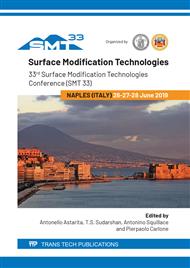[1]
R.C. Dykhuizen and M.F. Smith, Gas Dynamic Principles of Cold Spray, J. Therm. Spray Technol. 7 (1998) 205-212.
DOI: 10.1361/105996398770350945
Google Scholar
[2]
A. Papyrin, V. Kosarev, S. Klinkov, A. Alkhimov and V. Fomin, Cold Spray Technology, Elsevier Science, Amsterdam, (2006).
DOI: 10.1016/b978-008045155-8/50003-x
Google Scholar
[3]
V. Champagne, The Cold Spray Materials Deposition Process – Fundamentals and Applications, Elsevier Science, Amsterdam, (2007).
Google Scholar
[4]
H. Assadi, H. Kreye, F. Gärtner and T. Klassen, Cold spraying – a materials perspective, Acta Mater. 116 (2016) 382-407.
DOI: 10.1016/j.actamat.2016.06.034
Google Scholar
[5]
H. Assadi, F. Gärtner, T. Stoltenhoff, and H. Kreye, Bonding mechanism in cold gas spraying, Acta Mater. 15 (2003) 4379-4394.
DOI: 10.1016/s1359-6454(03)00274-x
Google Scholar
[6]
A. Sova, S. Grigoriev, A. Okunkova and I. Smurov, Potential of cold gas dynamic spray as additive manufacturing technology, International Journal of Advanced Manufacturing Technology 69 (2013) 2269-2278.
DOI: 10.1007/s00170-013-5166-8
Google Scholar
[7]
R. N. Raoelison, C. Verdy, and H. Liao, Cold gas dynamic spray additive manufacturing today: Deposit possibilities, technological solutions and viable applications. Materials & Design, 133 (2017) 266-287.
DOI: 10.1016/j.matdes.2017.07.067
Google Scholar
[8]
F. Ortega, A. Sova, MD. Monzón, MD. Marrero, AN. Benítez and P. Bertrand, Combination of electroforming and cold gas dynamic spray for fabrication of rotational moulds: feasibility study, The International Journal of Advanced Manufacturing Technology 76 (2015) 1243-1251.
DOI: 10.1007/s00170-014-6331-4
Google Scholar
[9]
A.P. Alkhimov, A.N. Papyrin, V.F. Kosarev, N.I. Nesterovich and M.M. Shushpanov, Gas-dynamic spraying method for applying a coating (US 5302414): Patent; (1994).
Google Scholar
[10]
S. Yin, Y.C. Xie, J. Cizek, E.J. Ekoi, T. Hussain, D.P. Dowling and R. Lupoi, Advanced diamond-reinforced metal matrix composites via cold spray: properties and deposition mechanism, Compos. Part B Eng. 113 (2017) 44-54.
DOI: 10.1016/j.compositesb.2017.01.009
Google Scholar
[11]
P. Sudharshan Phani, V. Vishnukanthan and G. Sundararajan, Effect of heat treatment on properties of cold sprayed nanocrystalline copper alumina coatings, Acta Materialia 55 (2007) 4741-4751.
DOI: 10.1016/j.actamat.2007.04.044
Google Scholar
[12]
K. Ogawa, K. Ito, K. Ichimura, Y. Ichikawa, S. Ohno, and N. Onda, Characterization of low pressure cold-sprayed aluminum coatings, J. Therm. Spray Technol., 17 (2008) 728-735.
DOI: 10.1007/s11666-008-9254-5
Google Scholar
[13]
Y. T. R. Lee, H. Ashrafizadeh, G. Fisher and A. McDonald, Effect of type of reinforcing particles on the deposition efficiency and wear resistance of low-pressure cold-sprayed metal matrix composite coatings, Surf. Coat. Technol., 324 (2017) 190-200.
DOI: 10.1016/j.surfcoat.2017.05.057
Google Scholar
[14]
R. Fernandez and B. Jodoin, Cold Spray Aluminum–Alumina Cermet Coatings: Effect of Alumina Content, J. Therm. Spray Technol., 27 (2018) 603-623.
DOI: 10.1007/s11666-018-0702-6
Google Scholar
[15]
H. Koivuluoto and P. Vuoristo, Structural analysis of cold-sprayed nickel-based metallic and metallic ceramic coatings, J. Therm. Spray Technol., 19 (2010) 975-989.
DOI: 10.1007/s11666-010-9481-4
Google Scholar
[16]
K. I. Triantou, D. I. Pantelis, V. Guipont and M. Jeandin, Microstructure and tribological behavior of copper and composite copper+alumina cold sprayed coatings for various alumina contents, Wear, 336-337 (2015) 96-107.
DOI: 10.1016/j.wear.2015.05.003
Google Scholar
[17]
Y. Wang, B. Normand, N. Mary, M. Yu, and H. Liao, Microstructure and corrosion behavior of cold sprayed SiCp/Al 5056 composite coatings, Surf. Coat. Technol., 251 (2014) 264-275.
DOI: 10.1016/j.surfcoat.2014.04.036
Google Scholar
[18]
Information on https://www.andra.fr/download/site-principal/document/innovation/coconut_ fiches-demantelement_web.pdf.
Google Scholar
[19]
F. Gärtner, T. Stoltenhoff, J. Voyer, H. Kreye, S. Riekehr and M. Koçak, Mechanical properties of cold-sprayed and thermally sprayed copper coatings, surf. Coat. Technol., 200 (2006) 6770-6782.
DOI: 10.1016/j.surfcoat.2005.10.007
Google Scholar


